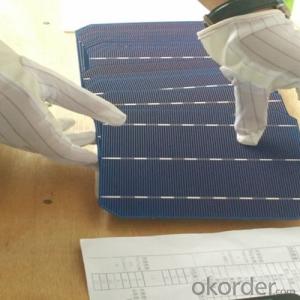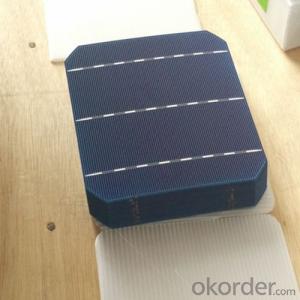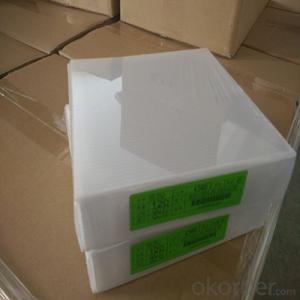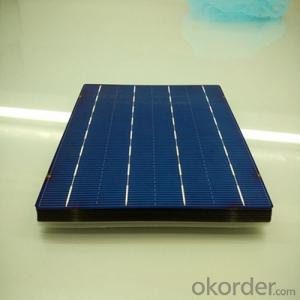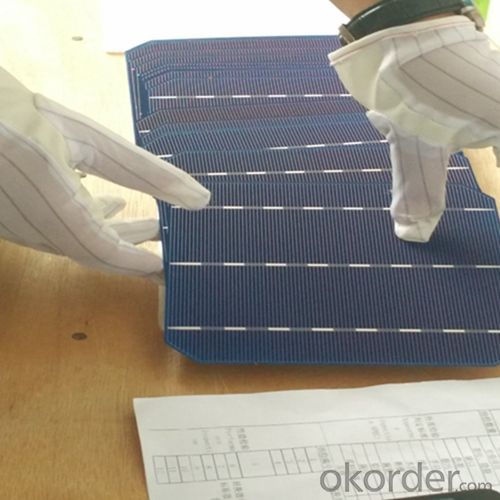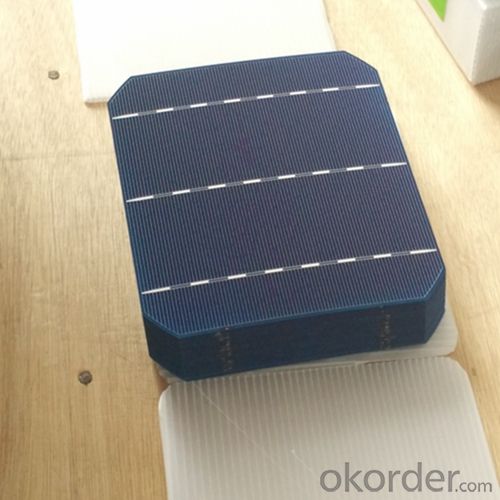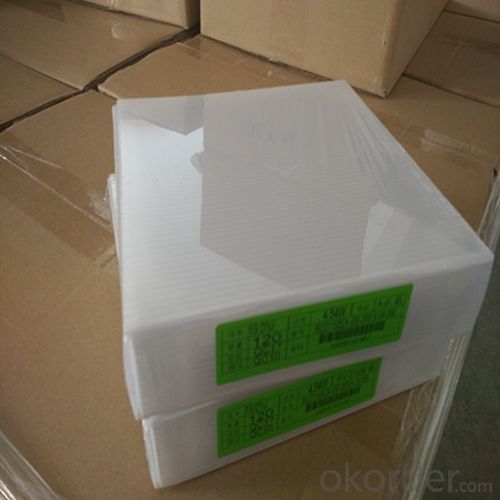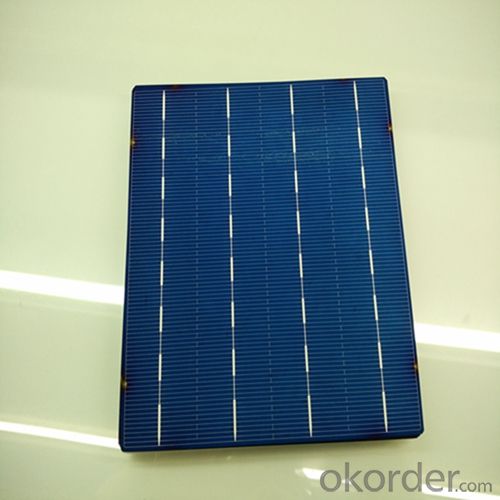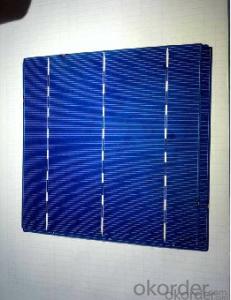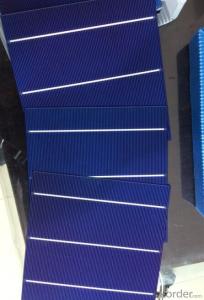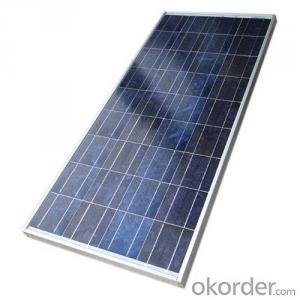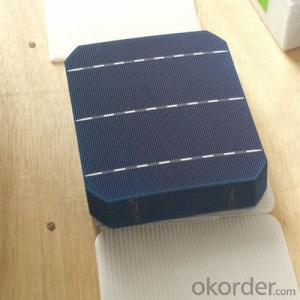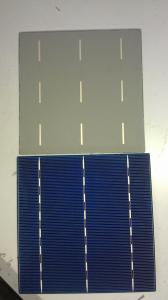Maxeon Gen 5 Solar Cells - Polymono 156x156mm2 Made in China
- Loading Port:
- Shanghai
- Payment Terms:
- TT OR LC
- Min Order Qty:
- 4999 watt
- Supply Capability:
- 6000000 watt/month
OKorder Service Pledge
OKorder Financial Service
You Might Also Like
The operation of a photovoltaic (PV) cell requires 3 basic attributes:
The absorption of light, generating either electron-hole pairs or excitons.
The separation of charge carriers of opposite types.
The separate extraction of those carriers to an external circuit.
In contrast, a solar thermal collector supplies heat by absorbing sunlight, for the purpose of either direct heating or indirect electrical power generation from heat. A "photoelectrolytic cell" (photoelectrochemical cell), on the other hand, refers either to a type of photovoltaic cell (like that developed by Edmond Becquerel and modern dye-sensitized solar cells), or to a device that splits water directly into hydrogen and oxygen using only solar illumination.Characteristic of Mono 156X156MM2 Solar Cells
You are gaining energy independence - add battery backup power for even greater energy security
The cost of electricity is only going to rise – insure against that rising cost
Adaptive cells change their absorption/reflection characteristics depending to respond to environmental conditions. An adaptive material responds to the intensity and angle of incident light. At the part of the cell where the light is most intense, the cell surface changes from reflective to adaptive, allowing the light to penetrate the cell. The other parts of the cell remain reflective increasing the retention of the absorbed light within the cell.[67]
In 2014 a system that combined an adaptive surface with a glass substrate that redirect the absorbed to a light absorber on the edges of the sheet. The system also included an array of fixed lenses/mirrors to concentrate light onto the adaptive surface. As the day continues, the concentrated light moves along the surface of the cell. That surface switches from reflective to adaptive when the light is most concentrated and back to reflective after the light moves along
Mechanical data and design
Format | 156mm x 156mm±0.5mm |
Thickness | 210μm±40μm |
Front(-) | 1.5mm bus bar (silver),blue anti-reflection coating (silicon nitride) |
Back (+) | 2.5mm wide soldering pads (sliver) back surface field (aluminium) |
Temperature Coefficient of Cells
Voc. Temp.coef.%/K | -0.35% |
Isc. Temp.coef .%/K | +0.024%/K |
Pm.Temp.coef. %/K | -0.47%/K |
Electrical Characteristic
Effiency(%) | Pmpp(W) | Umpp(V) | Impp(A) | Uoc(V) | Isc(A) | FF(%) |
18.35 | 4.384 | 0.526 | 8.333 | 0.63 | 8.877 | 78.39% |
18.20 | 4.349 | 0.526 | 8.263 | 0.63 | 8.789 | 78.54% |
18.05 | 4.313 | 0.525 | 8.216 | 0.63 | 8.741 | 78.32% |
17.90 | 4.277 | 0.524 | 8.161 | 0.625 | 8.713 | 78.04% |
17.75 | 4.241 | 0.523 | 8.116 | 0.625 | 8.678 | 77.70% |
17.60 | 4.206 | 0.521 | 8.073 | 0.625 | 8.657 | 77.36% |
17.45 | 4.170 | 0.519 | 8.039 | 0.625 | 8.633 | 76.92% |
17.30 | 4.134 | 0.517 | 8.004 | 0.625 | 8.622 | 76.59% |
17.15 | 4.096 | 0.516 | 7.938 | 0.625 | 8.537 | 76.80% |
17.00 | 4.062 | 0.512 | 7.933 | 0.625 | 8.531 | 76.18% |
16.75 | 4.002 | 0.511 | 7.828 | 0.625 | 8.499 | 75.34% |
16.50 | 3.940 | 0.510 | 7.731 | 0.625 | 8.484 | 74.36% |
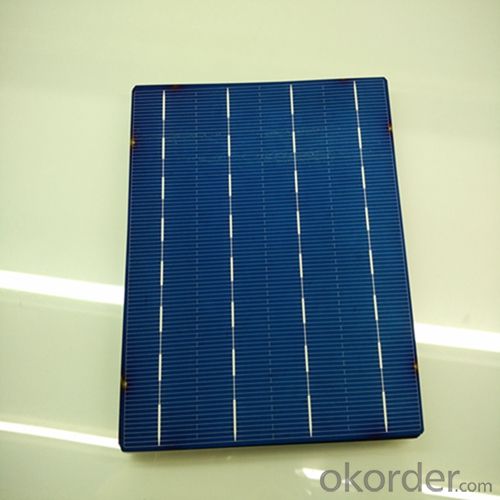
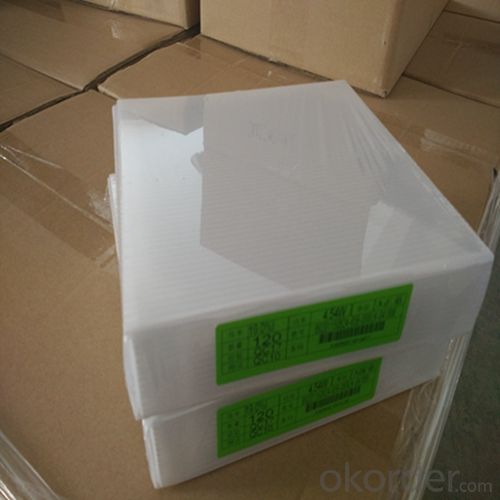
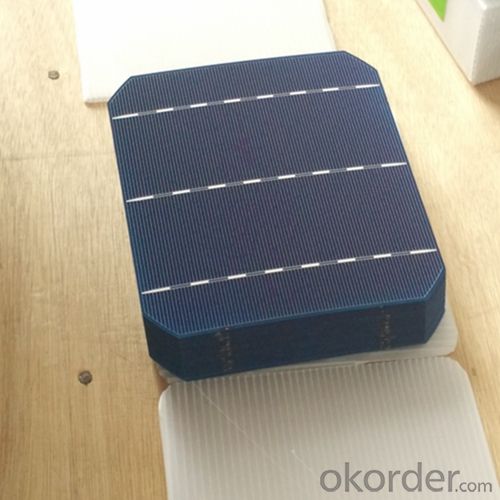
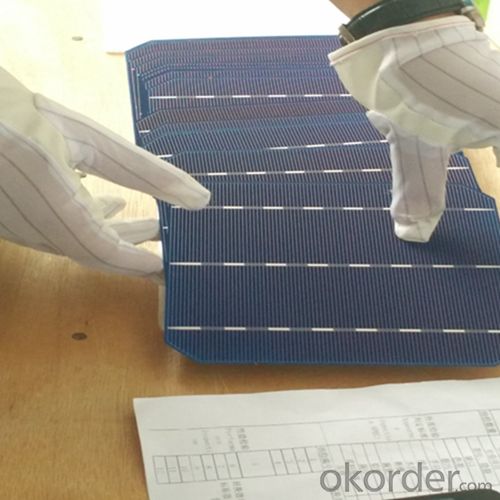
 FAQ
FAQ
Q: What price for each watt?
A: It depends on the quantity, delivery date and payment terms, generally Large Quantity and Low Price
Q: What is your size for each module? Can you tell me the Parameter of your module?
A: We have different series of panels in different output, both c-Si and a-Si. Please take the specification sheet for your reference.
Q: What is your size for each module? Can you tell me the Parameter of your module?
A: We have different series of panels in different output, both c-Si and a-Si. Please take the specification sheet for your reference.
- Q: Can solar cells be used in art installations?
- Yes, solar cells can definitely be used in art installations. They can be integrated into various artistic mediums and designs to provide a sustainable and visually stunning source of energy. This allows artists to create interactive and eco-friendly installations that promote renewable energy and environmental consciousness.
- Q: How can the huge solar cells be applied into the market?
- The huge solar cells are more used in the industrial project, which needs more power supply in one time. Without the huge solar cells, it might not be able to work at all.
- Q: Can solar cells be used to power parking meters?
- Yes, solar cells can be used to power parking meters. Solar cells convert sunlight into electricity, making them a sustainable and environmentally friendly power source for various applications, including parking meters. By harnessing solar energy, parking meters can operate independently, reducing the need for frequent battery replacements or connection to the electrical grid.
- Q: Can solar cells be used in recreational vehicles or boats?
- Yes, solar cells can be used in recreational vehicles or boats. They provide a reliable and eco-friendly source of power for charging batteries and running various appliances on board. Solar panels can be easily mounted on the roof of the vehicle or boat to harness sunlight and convert it into electricity, making them an ideal solution for off-grid power needs while enjoying outdoor activities.
- Q: What is the difference between solar cells and solar panels?
- Solar cells and solar panels are often used interchangeably, but there is a slight difference between the two. Solar cells, also known as photovoltaic cells, are the individual units that convert sunlight into electricity through the photovoltaic effect. On the other hand, solar panels are made up of multiple solar cells interconnected to form a larger module, which is capable of generating a higher amount of electricity. In simple terms, solar cells are the building blocks, whereas solar panels are the final product that harnesses solar energy for power generation.
- Q: What is the environmental impact of manufacturing solar cells?
- The environmental impact of manufacturing solar cells is relatively low compared to other forms of energy production. While the production process does require energy and resources, such as silicon, metals, and chemicals, it is offset by the clean energy the solar cells generate throughout their lifespan. Additionally, advancements in manufacturing techniques have significantly reduced the environmental footprint of solar cell production in recent years. Overall, the environmental benefits of using solar cells for clean energy generation outweigh the impact of their manufacturing.
- Q: What is the impact of bird collisions on solar cell performance?
- Bird collisions can have a negative impact on solar cell performance as they can damage or break the surface of the solar panels. This can lead to a decrease in efficiency and overall energy production of the solar system. Additionally, bird droppings and debris from collisions can also create shading, reducing the amount of sunlight reaching the panels and further affecting their performance.
- Q: How do solar cells perform in cloudy weather?
- Solar cells still generate electricity in cloudy weather, but their performance is reduced. Cloud cover reduces the amount of sunlight reaching the cells, resulting in decreased power output.
- Q: How do solar cells compare to other renewable energy sources?
- Solar cells have several advantages over other renewable energy sources. Firstly, solar energy is abundant and widely available, making it a more accessible option for many regions. Additionally, solar cells have a relatively long lifespan and require minimal maintenance, making them a cost-effective choice in the long run. Furthermore, solar energy is a clean and environmentally friendly source, as it produces no harmful emissions or pollutants. However, solar cells do have limitations, such as being dependent on sunlight availability and requiring large surface areas for installation. Overall, solar cells offer a promising and efficient solution for harnessing renewable energy.
- Q: What is the impact of wind on solar cell performance?
- The impact of wind on solar cell performance can be both positive and negative. On one hand, wind can help to cool down the solar panels, preventing them from overheating and maintaining their efficiency. Additionally, a gentle breeze can help to disperse any accumulated dust or debris on the panels, ensuring maximum sunlight absorption. On the other hand, strong winds can create vibrations that may damage the solar panels or the mounting structure, leading to potential performance degradation or even system failure. Therefore, while some wind can be beneficial, it is important to properly design and install solar panels to withstand and minimize any negative impact from strong winds.
Send your message to us
Maxeon Gen 5 Solar Cells - Polymono 156x156mm2 Made in China
- Loading Port:
- Shanghai
- Payment Terms:
- TT OR LC
- Min Order Qty:
- 4999 watt
- Supply Capability:
- 6000000 watt/month
OKorder Service Pledge
OKorder Financial Service
Similar products
Hot products
Hot Searches
Related keywords
